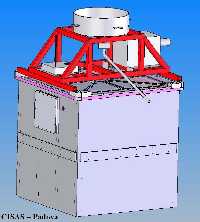Purpose of the flight and payload description
The instrument was designed to be flown as stand-alone payload under a stratospheric balloon to bring back aerosol samples where abundance, size distribution, composition and mineralogy will be measured for each class of materials collected.
A sampling of the stratosphere will invariably include particles from different sources with relative contributions that vary as a function of time, altitude, and possibly geographic location. At any time the stratosphere contains extraterrestrial dust, dust from natural terrestrial sources (volcanic dust, wind-blown dust, biomass burning) and dust related to anthropogenic activities. The dust is collected by direct deposition on both holey-carbon thin films supported by standard Transmission Electron Microscopy (TEM) grids and other substrates.
After the flight the collected dust is analysed in laboratory by Scanning and Transmission Electron Microscopy (SEM, TEM), Analytical Electron Microscope (AEM), X-Ray Fluorescence (XRF), Fourier Transform InfraRed (FTIR) spectroscopy, and Secondary Ions Mass Spectrometry (SIMS) without removing candidate particles, thus minimizing contamination by extraneous dust.
Details of the balloon flight

Balloon launched on: 4/7/2011 at 14:25 utc
Launch site: European Space Range, Kiruna, Sweden
Balloon launched by: Centre National d'Etudes Spatiales (CNES)
Balloon manufacturer/size/composition: Zero Pressure Balloon 100.000 m3
End of flight (L for landing time, W for last contact, otherwise termination time): 4/7/2011 at 19:35 utc
Balloon flight duration (F: time at float only, otherwise total flight time in d:days / h:hours or m:minutes - ): 5 h
Landing site: NE of Porsi, Sweden
: NO DATA AVAILABLE YET
External references
- Characterization of the DUSTER instrument for stratospheric dust collection and Raman analysis of stratospheric samples. De Angelis, Simone, Tesi di dottorato
- Duster Project pictures at Picasa web albums
- List of balloons launched from ESRANGE SSC Space website (via Archive.Org)
- Sampling the constant drizzle of meteoric dust in the upper stratosphere Meteoroids 2013, Proceedings of the Astronomical Conference,held at A.M.University, 2013
9679If you consider this website interesting or useful, you can help me to keep it up and running with a small donation to cover the operational costs. Just the equivalent of the price of a cup of coffee helps a lot.


